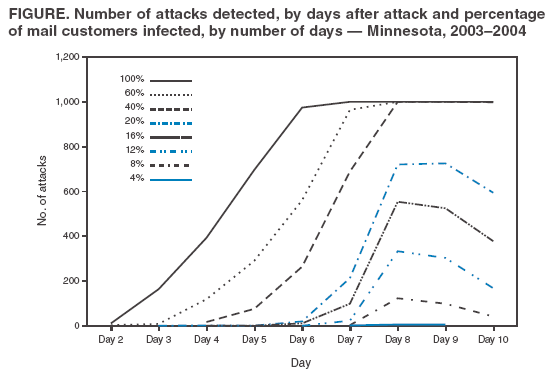 |
|
|
|
|
|
|
| ||||||||||
|
|
|
|
|
|
|
||||
| ||||||||||
|
|
|
|
|
Persons using assistive technology might not be able to fully access information in this file. For assistance, please send e-mail to: mmwrq@cdc.gov. Type 508 Accommodation and the title of the report in the subject line of e-mail. Use of Modeled Anthrax Attacks on the Mall of America To Assess Sensitivity of Syndromic Surveillance --- Minnesota, 2003-2004James D. Nordin,1 M.
Goodman,1 M. Kulldorff,2 D. Ritzwoller,3 A. Abrams,2 J. Donahue,4 J. Vest5
Corresponding author: James D. Nordin, HealthPartners Research Foundation, P.O. Box 1524 MS 21111R, Minneapolis, MN 55440-1524. Telephone: 952-967-5087; Fax: 952-967-5022; E-mail: james.nordin@healthpartners.com. Disclosure of relationship: One contributor to this report, D. Ritzwoller, has disclosed that she was a co-investigator on the grant noted in the report. The other contributors of this report have disclosed that they have no financial interest, relationship, affiliation, or other association with any organization that might represent a conflict of interest. In addition, this report does not contain any discussion of unlabeled use of commercial products or products for investigational use. AbstractIntroduction: The goal of syndromic surveillance systems is to detect and define biologic terrorism releases earlier than previously possible. These systems have rarely been evaluated. Objectives: This study measured a biologic terrorism surveillance system's sensitivity and timeliness. Methods: Models of an anthrax release in the Mall of America (Bloomington, Minnesota) were developed by using ZIP code data from the U.S. Census Bureau; data on mall visitors; and data provided by HealthPartners Medical Group, which covers 9% of the Twin Cities metropolitan population. For each infection level from 4% to 100%, 1,000 random dates during July 1, 2003--June 30, 2004, were selected with replacement for simulated releases. Timing of symptoms after release was based on data from the 1979 Sverdlovsk anthrax release. Cases from the simulated outbreak were added to respiratory visits recorded for those dates in HealthPartners' data. Analysis was performed by using the SaTScan™ space-time scan statistic (available at http://www.satscan.org) and Kleinman's generalized mixed model. Results: Timeliness and completeness of detection of events varied by infection rate (Figure). At a 40% infection rate, first events were detected by day 2; 25% by day 6; 75% by day 7; and 100% by day 8. Sensitivity decreased to <20% and timeliness increased to >40%. The system was most sensitive in summer, intermediate in fall and spring, and least in winter because of increased background rates of illness in winter. Sensitivity is better if a greater portion of the population is covered by the system. Conclusion: This biologic terrorism surveillance system can detect a modeled anthrax release in the majority of instances at a 20% infection rate and in all instances at a 40% infection rate. Figure Return to top.
Disclaimer All MMWR HTML versions of articles are electronic conversions from ASCII text into HTML. This conversion may have resulted in character translation or format errors in the HTML version. Users should not rely on this HTML document, but are referred to the electronic PDF version and/or the original MMWR paper copy for the official text, figures, and tables. An original paper copy of this issue can be obtained from the Superintendent of Documents, U.S. Government Printing Office (GPO), Washington, DC 20402-9371; telephone: (202) 512-1800. Contact GPO for current prices. **Questions or messages regarding errors in formatting should be addressed to mmwrq@cdc.gov.Date last reviewed: 8/5/2005 |
|||||||||
|